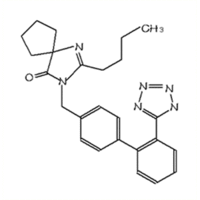Berl T, Hunsicker LG, Lewis JB, et al. Cardiovascular outcomes in the Irbesartan Diabetic Nephropathy Trial of patients with type 2 diabetes and overt nephropathy. Ann Intern Med 2003; 138:542-549.
* PRACTICE RECOMMENDATIONS
When added to antihypertensive treatment in patients with diabetes and nephropathy, neither the angiotensin receptor blocker (ARB) irbesartan nor the calcium channel blocker amlodipine reduced the overall occurrence of cardiovascular events. However, irbesartan decreased the rate of heart failure and amlodipine reduced the rate of acute myocardial infarction.
* BACKGROUND
Good control of blood pressure reduces microvascular and macrovascular complications in patients with diabetes more than control of blood glucose levels. (1) Further, the Antihypertensive and Lipid Lowering Treatment to prevent Heart Attack Trial (ALLHAT) demonstrated that diuretics should be first-line therapy for all patients with hypertension, including those with diabetes. (2)
ARBs are currently recommended by the American Diabetes Association as first-line treatment in patients with type 2 diabetes with nephropathy. (3)
* POPULATION STUDIED
This randomized, multinational study enrolled 1715 patients with type 2 diabetes, blood pressure >135/85 mm Hg, and frank nephropathy (mean 2.9 g/d of urinary protein). Two thirds of the patients also had retinopathy, nearly 30% had pre-existing cardiovascular disease, and over half took insulin. Patients were receiving multiple-drug antihypertensive regimens from their primary care physicians; those already taking ARBs, calcium channel blockers, or angiotensin-converting enzyme inhibitors were excluded.
* STUDY DESIGN AND VALIDITY
In addition to their usual antihypertensive treatment, patients were assigned to receive either placebo, amlodipine (Norvasc) 10 mg/d, or irbesartan (Avapro) 300 mg/d. Allocation to treatment assignment was concealed, and patients and investigators were blinded to treatment assignment. Patients were followed for 2.5 years; loss to follow-up was less than 1%. Analysis was by intention-to-treat.
Goal blood pressure was defined as <135/85 mm Hg. During the study, the average blood pressure was 140/77 mm Hg in the irbesartan group, 141/77 in the amlodipine group, and 144/80 in the placebo group. Patients in the irbesartan and amlodipine groups each received a total of 3 additional antihypertensive drugs, and the placebo group received an average of 3.3 nonstudy antihypertensives. One third received diuretics and nearly half received beta-blockers.
This was a valid study, but the sample size was not adequate to rule out a small but clinically relevant benefit of irbesartan. This was a secondary analysis of the Irbesartan Diabetic Nephropathy Trial, which evaluated renal protection. Reporting outcomes not part of the study design makes interpretation difficult, because statistically significant findings are likely to occur by chance alone if the investigators make numerous comparisons.
* OUTCOMES MEASURED
The combined outcome was the occurrence of at least 1 of the following: any acute myocardial infarction, unplanned coronary revascularization procedure, heart failure, stroke, or fatal coronary heart disease. Each outcome was also examined individually.
* RESULTS
Differences were small among the groups at baseline, but the investigators appropriately accounted for these differences in the analysis. Nearly one quarter of the patients discontinued the assigned treatment prematurely (mostly due to complications of therapy, protocol violations, or uncontrolled hypertension).
Overall, more than one third of patients experienced 1 of the cardiovascular endpoints. For the combined cardiovascular outcome, a trend toward benefit from irbesartan (hazard ratio [HR]=0.90) was not statistically significant. Heart failure was reduced among patients receiving irbesartan (HR=0.72; 95% confidence interval [CI], 0.52-1.00; number needed to treat [NNT]=15).
No benefits were seen in the combined outcome among patients receiving amlodipine, but myocardial infarctions were reduced (HR=0.58; 95% CI, 0.37-0.92; NNT=26) and, compared with irbesartan, heart failure was increased.
Adverse events were similar in all 3 groups, except that more hyperkalemia was seen in the patients receiving irbesartan.
REFERENCES
(1.) Snow V, Weiss KB, Mottur-Pilson C; Clinical Efficacy Assessment Subcommittee of the American College of Physicians. The evidence base for tight blood pressure control in the management of type 2 diabetes mellitus. Ann Intern Med 2003; 138:587-592.
(2.) ALLHAT Officers and Coordinators for the ALLHAT Collaborative Research Group. Major outcomes in high-risk hypertensive patients randomized to ace inhibitors or calcium channel blocker vs diuretic. The Antihypertensive and Lipid Lowering Treatment to prevent Heart Attack Trial (ALLHAT). JAMA 2002; 288:2981-2997.
(3.) American Diabetes Association. Standards of medical care for patients with diabetes mellitus (position statement). Diabetes Care 2003; 26:S33-S50.
Peter S. Millard, MD, PhD, Family Practice Residency Program, Eastern Maine Medical Center, Bangor. E-mail: pmillard@emh.org.
COPYRIGHT 2003 Dowden Health Media, Inc.
COPYRIGHT 2003 Gale Group



